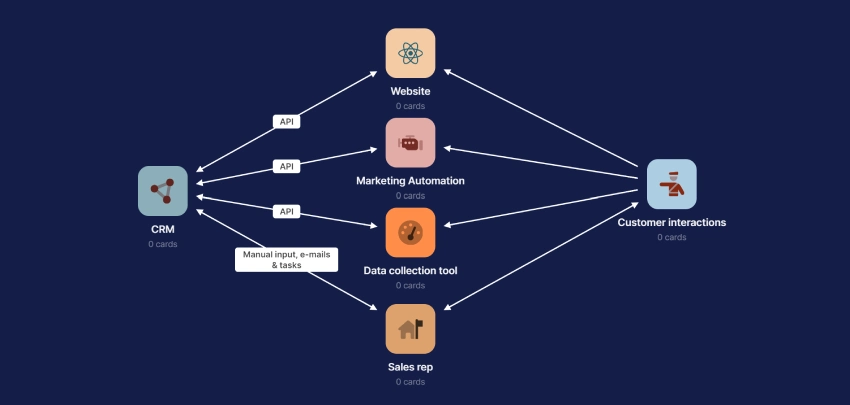How do you know your CRM data quality is up to standard? Customer Relationship Management is a vital part of your business’s commercial success. You track customer interactions and log information to build long-term relationships, generate leads, increase customer satisfaction, and boost sales. However, if the data in your CRM software is of poor quality, your tooling is basically worthless.
Poor data quality is a common problem among companies. You, as well as your business competitors, are bound to run into this.
Let’s explore some options to improve CRM data quality, so you can maximize the benefits of your CRM solution.
1. Define and document data standards
It starts with the implementation of CRM. Before you can start improving your CRM data quality, you need to define what good data actually looks like for you.
Just ask five team members what data belongs in CRM and how it should be entered. You can bet you’ll get five different answers.
Guidelines
This means you have to establish clear guidelines and standards for data entry, including fields that must be completed, the format of data, and any specific rules that must be followed. Include your team in this process and keep it simple!
It’s essential to document these standards and make them accessible to everyone in the organization who interacts with the CRM system. Sending an e-mail is not enough. You would do well to organize a training session and take the team through how you are going to ensure data quality together.

2. Train employees on data quality
Even the best data standards won’t be effective if your employees don’t know how to follow them. Providing comprehensive training on data entry procedures, including data quality best practices, is crucial. This training should be a part of onboarding for new employees and ongoing training for existing staff.
Make it fun! 😀
Tackle this smartly. Nobody is waiting for long boring training sessions on CRM data. Make it several short sessions with lots of interaction. Also, show how to make it easier for CRM users to monitor data quality. Demonstrate smart tools, for example, that fix errors or automatically load data into the system.
3. Verify data at the point of entry
You know what can really give you a headache? Cleaning up data that is already in the CRM system! Aim for a spotless data entry!
It’s essential to verify the accuracy of data as it’s entered into your CRM system. Implementing validation rules, such as checking for correct email addresses, URL’s, phone numbers, cities and postal codes, can help catch errors and reduce the number of inaccurate records.

4. Use automation
Automating data entry is an effective way to improve data quality. By implementing tools that can automatically update data fields, you can reduce errors and inconsistencies that result from manual data entry. For example, using email parsing software can extract information from customer emails and put it directly into your CRM software. CRM solutions evolve at lightning speed and data quality solutions follow automatically
External database sources are also very useful. Through these sources, you can automatically load company data into the system at the touch of a button.
5. Perform regular data hygiene
No matter how tight your processes are on the front end, there is always going to be sprawl in your CRM data. This automatically affects CRM data quality.
Regularly cleaning your CRM data is critical to maintaining its quality. This means correcting errors, removing duplicates, and updating outdated information. Look at the DMU information for different customers and prospects for example. A good rule of thumb is to perform data hygiene at least twice a year or after any changes in your business, such as a merger or a radical software modification.

6. Enforce data ownership
Make sure everyone in the organization understands who is responsible for maintaining specific data fields. By assigning data ownership to specific employees or teams, you can ensure that data is kept up-to-date and accurate. You can even choose to create a CRM KPI to monitor the progress of these activities.
Marketing, for example, is responsible for all data at the lead and prospect stages. Sales are responsible for all data around the sales opportunity. Account Management is responsible for all customer records.
7. Use a data quality tool
Using a data quality tool can help automate many of the steps outlined above. These tools can identify duplicates, enrich customer data with third-party information, and even help with data cleansing. Investing in a data quality tool can be an effective way to improve the overall quality of your CRM data. these kinds of tools for CRM data quality can be part of your CRM solution or offered by your CRM supplier.

8. Prioritize data security
In your search for as much useful and qualitative data as possible, you must also keep an eye on data security. Data security should be a top priority when it comes to CRM data quality. Make sure you have policies and procedures in place to protect customer information from data breaches and unauthorized access. This includes providing regular backups, restricted access to sensitive data, and using strong passwords and encryption.
In conclusion, improving CRM data
quality is a continuous process that requires ongoing attention and effort. By following the tips outlined above, you can start to improve the quality of your CRM data and reap the benefits of better customer relationships, increased sales, and improved productivity.
Remember to define data standards, train the employees, use automation, verify data, perform regular data hygiene, enforce data ownership, use data quality tools, integrate data sources, and prioritize data security.
However, it’s important to remember that improving CRM data quality is not a one-time event but rather an ongoing process. By continually monitoring and improving the quality of your data, you can ensure that your CRM system remains an essential tool for driving business success.
And with the right tools, training, and work processes in place, you can maximize the benefits of your CRM software and provide the right customer experience that sets your business apart from the competition.
Check our hand picked top 3 CRMs with Marketing Automation 👇
Recommended Reading
Which free CRM system is the best choice in 2024?
Looking for affordable CRM systems? We will go deeper into this in this article. Read along and discover free CRM for 2024!
6 Key CRM KPI’s every business should track (with examples)
6 Key CRM KPIs every business should track. Read everything about CRM KPIs and how to be successful using them
Sales qualification standard: BANT
What is BANT in relation to marketing and sales and how do you use it in your CRM? Read our insights on this topic!
Unveiling the AI revolution in CRM: 7 applications redefining business dynamics
Unveiling the AI revolution in CRM: 7 applications redefining business dynamics. How AI can help your business.
What is a DMU?
What is a DMU? DMU stands for Decision Making Unit and is often mentioned as a factor to consider in b2b purchasing processes.
The best CRM software for SMEs in 2024 (including tips and reviews)
Looking for SME CRM software? Take this deep dive into the world of CRM for smaller organizations and look for the best CRM solution for SMEs in 2024.
This website uses cookies. By continuing to use this site, you accept our use of cookies. Learn more
